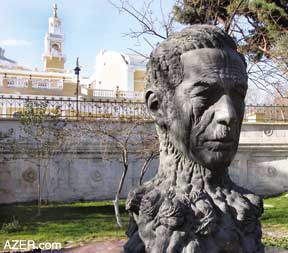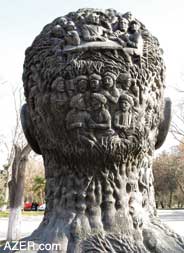|
Back to Ali & Nino Walking Tour Index
Above: The Ali & Nino Walking Tour begins in park below the Philharmonic Hall at the statue commemorating the work of poet Aliagha Vahid. A scene on the back of his head deals with many of the issues that are discussed in the the novel relating to the differences in Eastern and Western cultures. Photos: Blair. This statue of Azerbaijani poet Aliagha Vahid was designed by Rahib Hasanov and erected in 1990. Curiously, it was the last public sculpture to be erected in Baku before the Soviet Union collapsed at the end of 1991. Vahid's statue was selected as the point of origin for the "Ali and Nino Walking Tour" because the scenes depicted on the head of the sculpture so closely relate to some of the major issues of the novel. Take a walk around to the back of the statue on the head are two scenes, one juxtaposed above the other, depicting groups of men gathering. The scene on top shows a secular group of men, wearing Western clothing-suits. The scene below it depicts religious. Since the sculpture was created during the Soviet period, its goal was to praise the secularism over religious ideology. The novel, "Ali and Nino", essentially deals with these same issues of East and West, secular and religious set in the troubling and uncertain times just prior to the Bolshevik takeover of Baku. Here, Ali's Geography teacher introduces the leitmotif, which will be developed in magnificent detail throughout the book: Is Baku part of the East or the West? The teacher suggests that the issue is really up to the students to decide. From "Ali and Nino: A Love Story," pages 1 ff. "We were a very mixed lot - we 40 schoolboys who were having a Geography lesson one hot afternoon in the Imperial Russian Humanistic High School of Baku [Baku Modern School for Boys], Transcaucasia: 30 Mohammedans (Muslims), four Armenians, two Poles, three Sectarians and one Russian. "So far we had not given much thought to the extraordinary geographical position of our town, but now Professor Sanin was telling us in his flat and uninspired way: "The natural borders of Europe consist in the north of the North Polar Sea, in the west of the Atlantic Ocean, and in the south of the Mediterranean. The eastern border of Europe goes through the Russian Empire, along the Ural Mountains, through the Caspian Sea, and through Transcaucasia. "Some scholars look on the area south of the Caucasus Mountains as belonging to Asia, while others, in view of Transcaucasia's cultural evolution, believe that this country should be considered part of Europe. It can therefore be said, my children, that it is partly your responsibility as to whether our town should belong to progressive Europe or to reactionary Asia." "The professor had a self-satisfied smile on his lips. "We sat silent for a little while, overwhelmed by such mountains of wisdom, and the load of responsibility so suddenly laid upon our shoulders. "Then Mahmad Heydar, who sat on the back bench, raised his hand and said: "Please, sir, we would rather stay in Asia." "A burst of laughter. This was Mahmad Heydar's second year in the third form. And it looked as if he might stay there for another year if Baku kept belonging to Asia, for a ministerial decree allows the natives of Asiatic Russia to stay in any form as long as they like . . .The bell rang. Relieved, Professor Sanin left the room. "Forty pupils rushed out. It was the big break and there were three things one could do: run into the courtyard and start a fight with the pupils of the adjoining school, because they wore gold cockades [ornaments] and buttons on their school uniforms, while we had to be content with silver ones, or talk amongst ourselves in a loud voice in Tartar [Azeri] because the Russians could not understand it and it was, therefore strictly forbidden - or cross the street quickly and slip into the Girl's Lyceum of the Holy Queen Tamar. This I decided to do. . . . "My cousin Aishe waved to me. She was walking hand-in-hand with Nino Kipiani, and Nino Kipiani was the most beautiful girl in the world. When I told the girls of my geographical battle [Ali had expressed his preference for the Eastern mentality], the most beautiful girl in the world looked down the most beautiful nose in the world and said: "Ali Khan, you are stupid. Thank God we are in Europe. If we were in Asia, they would have made me wear the veil ages ago, and you wouldn't be able to see me. "I gave in. Baku's undecided geographical situation allowed me to go on looking into the most beautiful eyes in the world. I left the girls and dejectedly played truant for the rest of the day. "I looked at the camels, at the sea, thought of Europe and Asia, of Nino's lovely eyes and was sad. "A beggar approached me: his face and hands rotten with disease. I gave him money. He tried to kiss my hand, but I was frightened and snatched it away. Ten minutes later, it occurred to me that this had been an insult, and for two hours, I ran around looking for him so I could put it right. But I could not find him and went home with a bad conscience." Back to Ali and Nino Walking Tour Index Back to Index AI 12.2 (Summer 2004) AI Home | Search | Magazine Choice | Topics | AI Store | Contact us Other Web sites created by Azerbaijan International AZgallery.org | AZERI.org | HAJIBEYOV.com |


